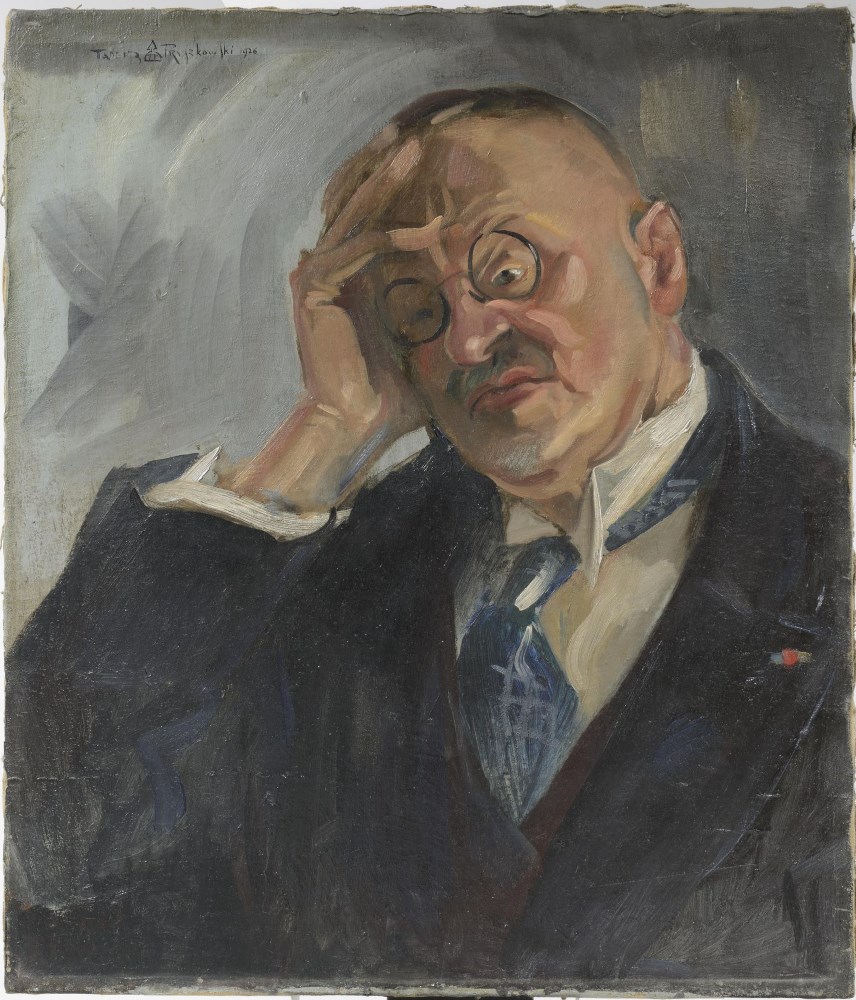Description:
Description of the painting:
“Portrait” of Tadeusz Pruszkowski was the last painting bought by Edward Aleksander Raczynski for the Rogaliński Gallery. As before the war, it can still be seen on the wall of the entrance hall. His expressive form closes the half-century of Raczynski’s collecting activity, which in the field of portrait painting and transformations, as they take place here, opens with the realistic “Boy” by Wacław Koniuszko, and continues with the linear-secessionist “Jewish Girl” by Jerzy Merkle.
“Portrait” is also one of the few works bought by Raczynski after regaining independence, indicating his ongoing interest in new trends in Polish painting. In this case, represented by the work of a graduate of the Warsaw School of Fine Arts (1904-1908), an outstanding pedagogue and animator of the artistic life, initiator and member of numerous creative groups, including: “Young Art”, “Rhythm”, “Brotherhood of St. Luke”, “Association of Plastics – Warsaw School”, “Masonic Lodge”, as well as the “Institute of Art Propaganda” and the “Block of Professional Artists”. Pruszkowski debuted in 1914, presenting his works at numerous exhibitions in the country and abroad. He was also the organizer of a number of exhibitions and the Art Department at the Powszechna Wystawa Krajowa in Poznań in 1929. During World War II, he provided assistance to Jews. He was shot by the Nazis during an attempted escape. He is best known as the author of numerous portraits of representatives of the world of politics and culture and landscapes from the area around Kazimierz Dolny, to which he traveled in the 1920s.
Being a teacher at the private school of Krzyżanowski, and later at the Warsaw School of Fine Arts (of which, after being renamed to the Academy, he became rector), he sought to develop a Polish formula of painting combining the observation of reality with the artistic culture acquired during contact with the works of the old masters. He had such an opportunity during his studies in Paris (1908-1911) and numerous trips to Brittany, Algeria and England. Following the footsteps of modern Italian-Dutch-Spanish achievements, he strove for technical perfection based on “perfect drawing and subtle tonal modeling, bringing out both the plasticity of forms and the quality of colors.” Much he owed to the influence of his master and friend Konrad Krzyżanowski “visible in the bold painting technique, in dynamic, impasto handling of paint, in expressive portraits. Looking at his paintings, one gets the pleasant impression of the pleasure and passion with which this artist paints (…)”.
An excellent example of such a characterization is the “Portrait” of Rogaliński, painted with verve. From sketchy-impasto, soft brush strokes emerges a figure of a distressed, tired man in the prime of life, which fills almost the entire painting field. Rightly built, he supports his balding head on his right hand. The expression of concern, obtained thanks to such a pose, is further enhanced by a sad face and a downward-looking, binocular gaze. The elegant dress with a white shirt, blue scarf, brown vest and a large gray suit finds a colorist complement in the gray-haired, neatly trimmed mustache and minimum beard, and the grays of the undefined, impressionistic background. The warm tone of the face with blushing cheeks finds delicate completion in the adorning lapel of the suit, white-gold-red beret of the Knight of the Commander’s Cross of the Order of “Polish Rebirth”. This is undoubtedly one of the keys to determining the identity of the portrayed, and perhaps the cause of such an excellently, expressively conveyed expression of pondering.


